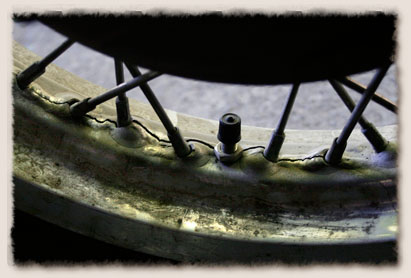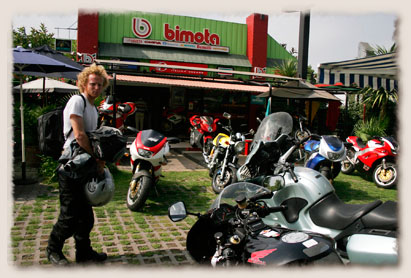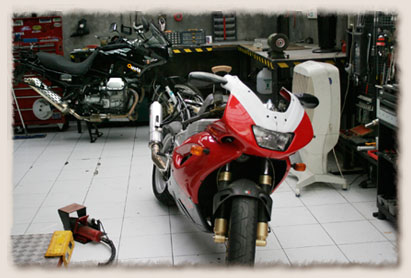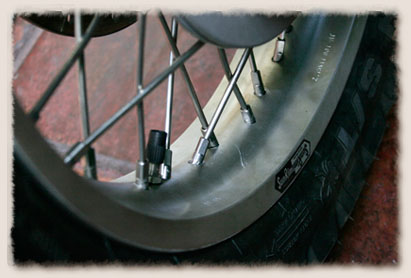Backtracking: Los Angeles , Chile and Santiago
January 29-31
“Is that a crack in the rim?” Holly asked as she stepped off the bike when we stopped for gas about 300 miles south of Santiago . I took a look. It was a crack, worse than before the rim was welded, about six inches long that went through the spokes and out across the side of the rim. “I think our riding is done for the day,” I replied.

| |
The welding cracked between a section of the spoke holes and we stopped in Los Angeles until we could figure out what to do next. |
From Santiago we planned a one-day, 600 mile ride through Chile 's southern Lake District on our way to Argentina . About half-way through our day, the ride ended. Ever since the welding repair in Lima , now about 3,000 miles ago, I checked the condition of the rim at every gas stop. It was fine 150 miles before Holly noticed the crack. Why the rim had decided to come apart in 150 miles of perfect Pan-American pavement, I don't know. From the gas station, the town of Los Angeles was only a few miles away. We rode there slowly. I hate having trouble on a Sunday because it means that you have to wait at least 24 hours until you can start to find a solution. Los Angeles is a small and dusty agriculture town that lies on the drier side of the border that divides arid middle Chile from the green southern part. In the town's central plaza we met some local motorcyclists while trying to find a hotel, who told us the little puebla had a motorcycle shop.
Bright and early the next morning I was on the shop's doorstep only to find a “Closed for Vacation” sign on the front door. I consulted the Internet and made a few calls, quickly discovering our only hope for a repair would be to turn around and backtrack to Santiago . Not trusting the rim with all of our weight, Holly and I went to the bus terminal to get her a ticket back to the capital. A power outage at the terminal turned our five minute purchase into a two and a half hour wait.

| |
We were at the counter at the bus terminal to buy a ticket for me to get back to Santiago when the power went off. We waited over two hours for it to come back on before we could buy a ticket. |
At 4 a.m. on Tuesday morning I was heading north for the first time on our trip, alone, also for the first time. The interstate was empty and I eased the bike up to 75 mph, riding solo making me braver as I focused on the bike's feedback from the wheels to notice any changes that might indicate the cracks were getting worse. At each stop for gas and each toll booth I pulled over and checked the rim. By daylight I was in Santiago and the rim hadn't gotten any worse. About the same time 300 miles away, Holly was boarding a bus in Los Angeles on her way to meet me. Searching on the Internet, I had found that Santiago did not have an official Moto Guzzi dealership, but they had a shop that specialized in Italian bikes. About 15 miles from the town's center in the affluent Providencia neighborhood, I pulled into Bimota Chile as employees were still rolling bikes on the front lawn.
Bimota Chile was unlike anything I had encountered on our trip. In every major city I had checked out bike dealerships and had yet to be impressed with anything I had seen. Even official major brand dealerships were lacking on selection, spare parts and skilled mechanics and usually packed into the back room of a small, run-down building. But standing in the middle of row after row of Bimotas, Ducatis, MV Agustas and Moto Guzzis, I knew I had found something different. The service manager, Javier, told me they would search for a replacement rim and took me on a tour of a shop that looked that looked like an operating room, complete with a tire changing machine and wheel balancing stand. I left, feeling like the Guzzi was in the best hands within 10,000 miles, and took an expensive taxi ride back downtown.

| |
Jeremiah was in sport bike heaven at the Bimota motorcycle dealership. |

| |
The shop washed and waxed the Guzzi while it sat in their spotless shop. |
Holly and I had picked a hostel, where we were supposed to rendezvous. Her bus was scheduled to arrive at 4 p.m., and at that time I was parked on the front step of our sidewalk with a book. At five after a yellow and black taxi pulled up. It was empty and the driver parked on the curb. I fidgeted and tried to concentrate on my book, glancing at every taxi that passed, looking for one to slow. Ten minutes later, a second taxi stopped with Holly in the back seat. I canceled the stopwatch that I had started when I pulled out of Los Angeles . Twelve hours, forty-two minutes and thirteen seconds since we separated. It seemed like two years. That evening, Javier called with bad news. Just like Peru , a replacement rim was not to be found within the entire country of Chile . I had spent the rest of my afternoon traveling around to all the other dealerships and motorcycle salvage shops, also without luck. One reason I had purchased the Guzzi was that its 21” front and 17” rear wheels were a common size, often found on the dirt bikes that flooded South American streets. Tires had been easy enough to find, but the rim was something different. The snag was that the Guzzi's rim used 40 spokes. Most dirt bikes use 36. As I searched around Santiago I found several 2.75” X 17” rims. All had 36 spokes.
Javier offered to get the rim welded. This had seemed like a good idea in Lima , but it hadn't worked. With 4,000 miles of rough and isolated road ahead between us and the next major town, Holly and I decided that we needed to do something else. I called Buchanan's, the manufacturer of Sun rims, in California . Buchanan's makes a replacement rim for the Guzzi and told me they could have it shipped to Santiago in three to five days. We purchased the rim and started the “wait.”

| |
The inside of the rim had been welded in Lima , but the entire rim was cracking through and through. |
One week later, the Web site of the United States Postal Service listed the rim as being “in customs.” The status didn't change for the next four days. On Saturday, Javier called. The Bimota shop was going to be closed for the next two weeks, and since the rim wasn't there, I would have to come pick up the bike. By the time I arrived, they had reassembled the cracked rim and wheel. They didn't have any recommendations of who else in Santiago could help me. Heading back downtown I stopped at Santiago Harley-Davidson. A mechanic there recommended Maico Sport, an independent motorcycle shop just up the street. The shop was closed by the time I arrived, but owner and head mechanic Maico was still there, opening the gates to let me bring my bike in and offering to lace the rim.
After spending a relaxed and helpless Sunday, we woke on Monday morning resolved to get something done. USPS ships packages to other countries, where they are picked up by another carrier and delivered. The USPS customer service representatives couldn't tell me who delivered packages for them in Chile . I traveled to the FedEx terminal and Chilean National Post Office, both downtown. Both said they didn't deliver for USPS. I decided to head to the airport.
An hour's bus and subway train ride later, I was at the airport's cargo terminal, resolved to go door to door until I found who handled incoming USPS shipments. In the first door I entered, the office of Epo Cargo, I asked for someone who could speak English. Within minutes I was in the office of Ricardo Kausel. Although his company didn't have the package, Ricardo called around the airport until he determined that the Chilean National Post Office had the rim and then offered to walk me to their warehouse. There we discovered that the rim had just been loaded onto a truck that was heading to Santiago . Ricardo took the time to give me directions to the warehouse before wishing me luck and sending me on my way.
From the airport's location 20 kilometers north east of Santiago I traveled by bus and subway to La Reina neighborhood in the city's southeast corner. I arrived at the Correo Nacional office to see a box, with dimensions of approximately 2.75” X 17”, with a Buchanan's sticker sitting on the shelf behind the counter. As I reached for the package I was stopped. I still had to pay import duties. The postal service couldn't accept the money. I had to pay across the street at the bank, which were just locking their doors for their afternoon lunch breaks.
Two hours later I had traveled to all of the six banks that occupied the opposite side of the street and had finally found one that accepted my payment. Back across the street, there was still a dollar charge to be paid to the post office before the package was in my hands. I opened the box on the floor in front of the counter to find a brand new Sun aluminum rim, sized 2.75” by 17” with 40 spoke holes, complete with a set of heavy duty spokes and nuts. I repacked the box and took a bus to Maico Sport.
The mechanics at Maico said the bike would be finished in two to three days. Three days became four, became five, but on Saturday morning we collected the finished bike and headed back through downtown traffic towards our hostel, stopping for gas in anticipation of the next day's ride. It was the first time Holly had been on a motorcycle in three weeks.

| |
The new Sun rim freshly installed so we could be on our way. |

| |
Spit-polished and ready to go we rode away from the mechanic shop on a Saturday morning. |

| |
We got an early start to our first day back on the rode in three weeks. |
|